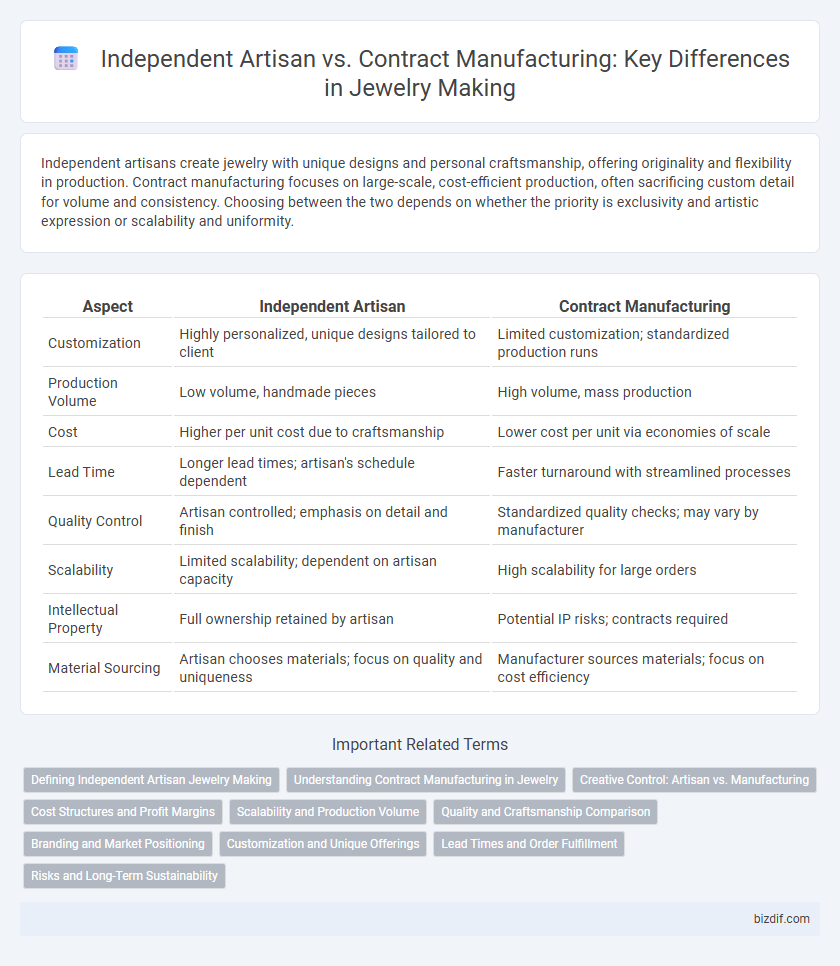Independent artisans create jewelry with unique designs and personal craftsmanship, offering originality and flexibility in production. Contract manufacturing focuses on large-scale, cost-efficient production, often sacrificing custom detail for volume and consistency. Choosing between the two depends on whether the priority is exclusivity and artistic expression or scalability and uniformity.
Table of Comparison
| Aspect | Independent Artisan | Contract Manufacturing |
|---|---|---|
| Customization | Highly personalized, unique designs tailored to client | Limited customization; standardized production runs |
| Production Volume | Low volume, handmade pieces | High volume, mass production |
| Cost | Higher per unit cost due to craftsmanship | Lower cost per unit via economies of scale |
| Lead Time | Longer lead times; artisan's schedule dependent | Faster turnaround with streamlined processes |
| Quality Control | Artisan controlled; emphasis on detail and finish | Standardized quality checks; may vary by manufacturer |
| Scalability | Limited scalability; dependent on artisan capacity | High scalability for large orders |
| Intellectual Property | Full ownership retained by artisan | Potential IP risks; contracts required |
| Material Sourcing | Artisan chooses materials; focus on quality and uniqueness | Manufacturer sources materials; focus on cost efficiency |
Defining Independent Artisan Jewelry Making
Independent artisan jewelry making involves individual craftsmen who design and create unique pieces by hand, emphasizing personal creativity, skill, and artistic expression. Unlike contract manufacturing, which relies on mass production and standardized processes, independent artisans prioritize customization, quality materials, and intricate craftsmanship. This approach ensures each piece reflects the artisan's unique vision and maintains exclusivity in the jewelry market.
Understanding Contract Manufacturing in Jewelry
Contract manufacturing in jewelry involves outsourcing production to specialized companies that fabricate pieces based on a designer's specifications, ensuring scalability and consistent quality. This approach allows independent artisans to focus on creative design and branding while leveraging the technical expertise and advanced machinery of contract manufacturers. Understanding contract manufacturing helps jewelers balance cost-efficiency with craftsmanship, meeting market demand without compromising artistic integrity.
Creative Control: Artisan vs. Manufacturing
Independent artisans maintain full creative control over jewelry design, enabling unique, handcrafted pieces that reflect personal artistry and original vision. Contract manufacturing often limits creative input, as designs must adhere to client specifications and mass production requirements. This distinction impacts the individuality and exclusivity of the final jewelry product.
Cost Structures and Profit Margins
Independent artisans typically face higher upfront costs for materials and tools but benefit from greater control over design and direct customer relationships, often resulting in higher profit margins per piece. Contract manufacturing reduces initial investments and labor costs by outsourcing production, leading to lower per-unit costs but slimmer profit margins due to shared revenues and less differentiation. Effective cost management and pricing strategies are crucial for both models to maximize profitability within the competitive jewelry market.
Scalability and Production Volume
Independent artisans typically produce unique, handcrafted jewelry pieces with limited scalability and low production volumes due to the labor-intensive process. Contract manufacturing, by contrast, enables high scalability and large production volumes through automated processes and standardized designs. Businesses aiming for rapid growth and mass distribution often prefer contract manufacturing to meet market demand efficiently.
Quality and Craftsmanship Comparison
Independent artisans create jewelry with meticulous attention to detail, ensuring each piece reflects unique craftsmanship and high-quality materials. Contract manufacturing often involves mass production techniques that may compromise the intricacy and personalized touch found in artisan work. The superior quality and individuality of handmade jewelry by independent artisans typically surpass the uniformity produced in contract manufacturing settings.
Branding and Market Positioning
Independent artisans cultivate unique brand identities through handcrafted, signature designs that resonate with niche markets seeking authenticity and exclusivity. Contract manufacturing offers scalability and consistency but may dilute brand differentiation due to standardized production processes. Strategic focus on custom craftsmanship enhances market positioning by emphasizing originality, while contract manufacturing suits mass-market brands prioritizing volume and cost efficiency.
Customization and Unique Offerings
Independent artisans craft jewelry with personalized designs that reflect unique artistic vision and client preferences, resulting in highly customized, one-of-a-kind pieces. Contract manufacturing focuses on mass production which limits customization, emphasizing consistent quality and scale over individuality. Choosing an independent artisan ensures exclusive, tailor-made jewelry that stands out in a market dominated by standardized products.
Lead Times and Order Fulfillment
Independent artisans in jewelry making often offer shorter lead times due to their hands-on approach and smaller order volumes, enabling quicker customization and personalized craftsmanship. Contract manufacturing typically involves longer lead times as production scales up with bulk orders and standardized processes but benefits from predictable and consistent order fulfillment. Choosing between the two depends on whether faster turnaround or high-volume consistency is the priority in the jewelry supply chain.
Risks and Long-Term Sustainability
Independent artisans in jewelry making face risks such as limited scalability and dependency on personal skill, which can challenge long-term sustainability. Contract manufacturing offers scalable production and consistent quality but risks include loss of creative control and potential intellectual property issues. Choosing between the two requires balancing artistic integrity and business growth to ensure enduring success in the jewelry industry.
Independent artisan vs Contract manufacturing Infographic

 bizdif.com
bizdif.com